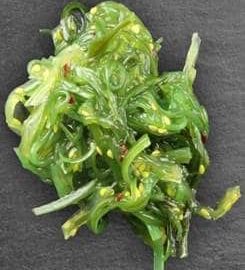An edible sea vegetable with a minerally and salty flavour, seaweed is one of the most famous sea vegetables. Discover how to use seaweed and what you can cook with it.
The distinctive flavour of seaweeds, regardless of their shape, size, or colour, including red, black, brown, and green ones, is similar to that of iodine and fish oil.
The Japanese use kombu kelp to produce dashi, an essential ingredient for soups and stocks, with a subtle flavour that is easy to enjoy. As for Nori, it is a paper-thin sushi roll wrap made from brown algae and green algae.
In some form or another, seaweed’s salty, metallic iodine flavour will always be present. It’s easy to compare seaweed and land-based foods, but they will always taste like seaweed, regardless.
The laverbread of Wales is the most popular in the UK, made from long-cooked kelp, but it was never popular, not even among Welsh. Eating enough seaweed or aquatic plants is essential to benefit from their nutritional value.
A selection of organic dried seaweeds from Northern Spain is the backbone of our seaweed range. Seafood salad, kombu or kelp, wakame, sea spaghetti, and sea lettuce are also available. Additionally, laver and samphire are essential ingredients in British and Japanese cuisine. They are both frozen.
Sources of Edible Seaweed Species
There are oceans and aquatic environments around the world where wild seaweed can be found. Today, most seaweeds are produced by seaweed farming, although some seaweed is gathered from its surroundings in the wild.
Some farmers grow green and brown seaweeds in tanks filled with salt water. Others have seaside gardens. Seaweed is cultivated on ropes by farmers to keep a close eye on the growth process and ensure that unwanted marine life and plants are removed before harvesting.
Seaweed: Is It Healthy to Eat It?
A superfood, seaweed is often described as an ingredient that can be consumed. This food has many health benefits, including nutrients, antioxidants, and B12, C, A, and E vitamins.
In Stock
Products made with laverbread, a blackish-greenish substance enriched with iron and iodine, can be ordered online. Online seafood shops and Asian stores also offer dried seaweeds and sea vegetables.
A novice can only make an accurate judgement if they taste the food. Buy only a few units from a well-established supplier.
Storing Seaweed
There should be a use-by date on sealed, vacuum-packed laverbread, which should be months away, not a few weeks from now. Make sure dried goods are packaged according to the guidelines.
Cooking Seaweed
In Wales, laverbread is often served with sea cockles and mutton meat. Various hearty meals can be combined or eaten with it, including fried eggs accompanied by bacon or ham, spicy sausages, or smoked fish.
In addition to using green or brown seaweed as a main ingredient, you can also use it as a garnish. The practice is both familiar and exciting. It looks beautiful sprinkled on poached fish; try adding some to the water next time.
Seaweed Recipes
The Asian food aisle of a large grocery store, as well as the specialty aisles of Asian food stores, are the most common places to buy seaweeds. These seaweed recipes are a great way to incorporate a healthy ingredient into your diet.
A salad made with seaweed
This salad uses wakame noodles and is tangy and refreshing. Please make sure the wakame is hydrated by soaking it in water. Squeeze excess water out of the seaweed after draining. Slice the wakame thinly and add it to a bowl with chopped scallions, cilantro, and carrot. Add soy sauce, rice vinegar, sesame oil, sugar, ginger, and red pepper flakes in another bowl. You can sprinkle sesame seeds on the wakame salad after you pour the dressing on top.
Smoothie with seaweed
The possibilities for making a smoothie are endless. The addition of seaweed gives this basic recipe an added dose of health. A smoothie is made by blending almond milk, frozen bananas, spinach, strawberries, and a seaweed of your choice, perhaps Irish moss or ground alaria, all at once. If you add a bit of agave syrup, it will taste sweeter. Make a smoothie and serve it.
Dashi
Ramen or tsukudani can be served with this traditional Japanese broth. Take kombu seaweed and rehydrate it in water for 30 minutes. Afterwards, place it on medium heat and turn it off as soon as it boils. Take the kombu out, add the bonito flakes, and simmer for 5 minutes. Put the liquid in a colander and strain it.
Tsukudani
Seaweed flavoured with liquid is another Japanese staple, tsukudani. This recipe uses nori or kombu. Seaweed sheets should first be rehydrated, then dried, and sliced thinly. Stir the seaweed into the dashi as it cooks on medium-high heat. Add sake, mirin, soy sauce, and rice vinegar within five minutes of thickening. The liquid should be absorbed by the time it reaches the end of cooking. You can serve it over rice and sprinkle sesame seeds on top.
